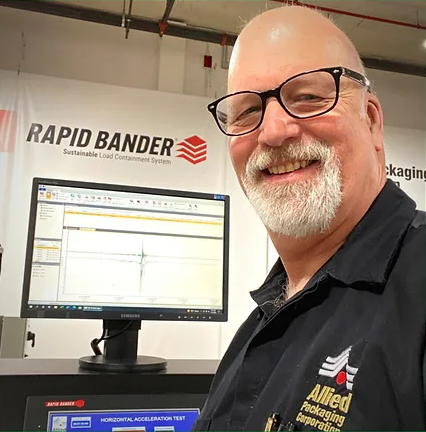Ask Steve
August 22, 2023
Question from Rob: How do the new high-performance stretch films compare to your Rapid Bander.
Hi Rob, great question, and one I am certainly not afraid to answer. For many years there was little advancement in stretch film technology because, after all, it’s just something you wrap around the product before it ships! More recently, when pressed by customers experiencing significant load failures, stretch film companies began looking closer at various resin blends to achieve higher performance. And by higher performance, I mean an improvement in load containment.
By Adopting more complex resin blends and upgraded manufacturing techniques, they were able to deliver improved performance while downgauging the film. I have to say, compared to the starting point, a lot of improvement was made.
In working closely with both stretch wrap equipment and stretch film manufactures over the years, I have found that while they are experts in their respective fields, there is a distinct gap of knowledge when it comes to the science of load containment. In other words, understanding the mechanism of a load failure. Forces are applied to the load during transportation; it’s a fact, so the study of load containment starts with analyzing how the load reacts to those forces, and how effective the secondary packaging is to counter those forces. There are some extraordinary forces which no load will survive, no matter what type or how much secondary packaging is applied. For this discussion, we will only deal with what I refer to as expected forces which fall into three categories, and those are:
- Normal Driving Conditions: turning, accelerating, braking, traveling up and downhill.
- Extraordinary Impact Forces: trucks hitting dock bumpers HARD, railcar coupling, trailers jumping curbs.
- Panic Braking: trucks suddenly lock up all 18 wheels as they skid to a panic stop.
Each of these has a distinct profile which will affect a load much differently. We create each of those force types in our lab, allowing us to “see the anatomy” of a load failure. We use the data we collect from testing to gain an understanding of the countermeasures needed to prevent failure. Analyzing the physics of load failure has led us to develop systems like our patented Rapid Bander, Rapid Roper, and Rapid Roper Plus as well as the Rapid Film resin formulations (which complement them).
Stretch film must “unitize” the load, meaning that the wrap pulls together all the components (boxes, bags, pails, bundles, etc.) compressing them so there is little to no movement of the individual components. This is “force-to-load”, a term you have probably heard used. Most stop right there, assuming that is the effective measurement of load containment. However, there is a critical component of load containment missing: Total Applied Stretch, which is the difference between the length of film dispensed from the roll and the length applied to the load, or total stretch of the film. All stretch films provide some resistance to stretch, which will vary the further it is stretched. There is a range of stretch where the film becomes stiffer and its resistance to further stretching is maximized; this typically happens just before it fails. Knowing the total applied stretch indicates whether that film is operating in its peak performance range. This is important because if the film continues to stretch as forces are applied, after the load has been wrapped, the load containment is drastically reduced. More recent high-performance films can be stretched a little further than earlier films, providing more resistance to continued stretching. But when they reach their maximum level of performance, there are frequent web breaks. When this happens, operators typically turn the tension down, and while that eliminates the web break issue, it also greatly diminishes load containment performance. Occasionally, you may find a stretch film that resists web breaks while being stretched at a very high percentage, but it typically doesn’t have the stiffness required to counter transportation forces and will continue to stretch compromising load containment.
This background is important to recognize the difference in our approach to stretch wrap.
Because we started with an understanding of the anatomy of load failures, the Rapid Technologies products were developed to achieve significantly more total applied stretch and stiffness, therefore, providing far more resistance to continued stretch during transportation. We understand that stretching the film enough to make it “work” means that we are dancing on the edge of web breaks. To prevent web breaks, and to reinforce the web, we add a second roll with bands or filaments that are laminated into the full web during pre-stretch. These reinforcement filaments allow us to comfortably push maximum film stretch and maximum load containment performance that others can’t achieve without web breaks, and since we stretch the film further, your film usage is significantly decreased, along with the frequency of roll changes.
In a nutshell, on paper, films may be seen to have similar properties to Rapid Technologies, however, in practice we are miles apart. I am not knocking other films on the market, we have tested most, and there are some very good ones out there, but if load containment, reduction in source content, reduction in your annual film spend, or increased machine throughput are important to you, the comparison is like the difference between night and day.
Thanks for asking!








